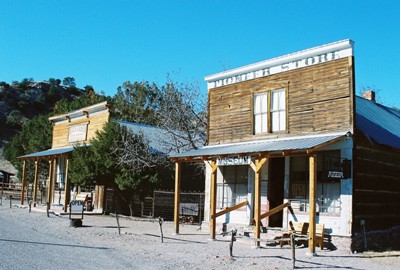
I’ll admit that many of the places I visit are run-down and lonesome and the tales tend to get a little dark. Sure, I guess I like it that way. But this post will be a little ray of sunshine. Don’t worry, it won’t last long.
Chloride, New Mexico (pop. 7) has risen like a phoenix from the ashes to become a ghost town no longer, but a fascinating Old West museum piece. It’s like stepping into a valley in a land that time literally forgot. But it hasn’t always been this way.
First of all, Chloride is a bit out of the way. You have to follow Highway 52 west WWAAAYY out and when Winston (founded by citizens who once thought Chloride too rowdy to abide) finally appears, turn off on a gravel road amusingly named Wall Street. When Wall Street ends smack dab up against the Gila National Forest you’ll know you’re there. I have absolutely no idea how folks managed to get to the place before there were roads. But, in 1879 Harry Pye, an Englishman, was somehow hauling a wagon load of supplies north to Ojo Caliente for the army. As the sun began to set he decided to seek shelter from the Apaches that populated the area. When he awoke he saw silver chloride nearby and later came back with some friends to stake a claim. Again, if you see the landscape surrounding Chloride, you can’t help but wonder about the agony that must’ve been inherent in the simple statement “came back with some friends.” I don’t know how they even found the claim again.
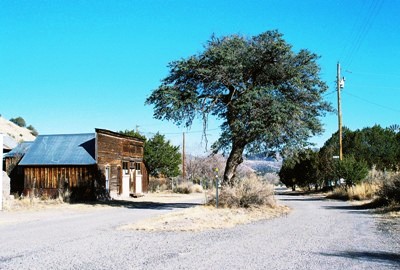
In any case, the tent city that sprang up was called Pyetown and Bromide and finally Chloride for that first silver chloride find and within a couple years hundreds of miners had flocked to the area to seek their fortunes near the “Pye Lode.” But by this time Pye himself was already dead, having indeed been killed by Apaches while camping shortly after his return. Alright, so maybe that IS a little dark. I suppose it’s the nature of the material. Pye was eulogized as being “an honest, sober, and industrious young man and a good miner and prospector. He had many friends in camp…”. People always say very nice things about you when you’re dead.
In Pye’s absence, Chloride boomed and was soon the center for all silver mining in the surrounding area. However, the town was 100% male, so free property was offered to the first woman brave (or foolish) enough to move to the town. Property (or perhaps a seat on the town council) was also to be given to the father of the first baby, “If it is known who he is.” I wonder if that got the ladies flocking to Chloride.
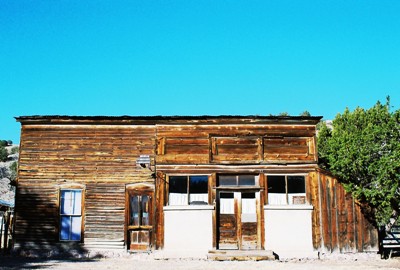
Chloride peaked in the 1880’s with a population of perhaps 3,000. In order of likely importance, there were nine saloons, three general stores, an assay office, a stage line, restaurants, butcher shops, a candy store, a lawyer's office, a doctor’s office, a hotel, boarding houses, and a Chinese laundry. Eventually some ladies did arrive and at least one brothel opened, although there were likely more. Being so remote, the railroad never made it out, which was somewhat unusual for a relatively major mining town. Transportation was only via stages and wagons.
By the turn of the century, the price of silver was dropping and so were hopes for Chloride’s future. When Philip Varney visited in the 1970’s to do a feature for his book, “New Mexico’s Best Ghost Towns,” the town was as one might dream a ghost town would be: historic, desolate, beautifully intact. Varney says as much in the introduction to his piece.
Looking at Varney’s pictures, it’s hard not to want to have seen Chloride in its virtually abandoned state. The photo below of Chloride’s two major false front buildings--one a general store, the other the old Monte Cristo Saloon--from Varney’s visit is particularly appealing. But perhaps that’s because I now know what had been collecting dust and dirt and bat droppings in the building with the faded “Pioneer Store” signage when that shot was taken.
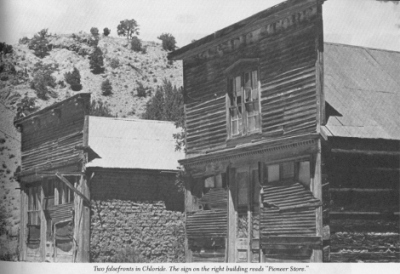
The Pioneer Store was built in 1880 by James Dalglish, who had come from Canada hoping that the high desert would help his ailing health. He ran the store through 1897 and sold absolutely anything anyone could want in a town like Chloride. As mining waned, the store was sold and then sold again with the James family finally running the place until nearly every resident of Chloride had moved away. That was about 1923. At that time the store was closed with its contents sealed-up inside and that was that for several decades.
In the late 1980’s, Mr. and Mrs. Edmund moved to Chloride and met Mr. James. He agreed to sell the store to the couple and, in 1989, they began the massive job of cleaning up the place and its contents, which included items spanning its entire history from 1880-1923. We’re talking such things as old whiskey bottles still containing whiskey, farm implements, clothes, kitchen wares, and Native American artifacts. The clean-up process wasn’t completed until 1998, but now the Pioneer Store is a museum showcasing much of what it sold in its original heyday. It’s pretty incredible and a person has to see it for themselves to truly appreciate how rare and fascinating a find this is.
Mrs. Edmund was very generous with her time during our visit, telling us about individual items and the painstaking process of bringing everything back to life. Then she took us next door to the Monte Cristo Saloon, now an art gallery and store. I bought some artisan honey from Hillsboro 'cause I really like honey. A walking tour led us past the old “hangin’ tree” and another old saloon that became the post office until it, too, closed. They're pictured in the second and third photos above, respectively. Only one person was ever hung from the “hangin’ tree”—and he by effigy—but numerous drunks were chained to it until they sobered up. There is an odd building called the “Doodle Dum” (pictured below), built by its owner in 1920 out of stone and with a steeply-pitched roof to withstand the fierce hailstorm that he believed God was preparing for mankind. Original law offices and the U.S. Treasury Mining Company Headquarters also still stand.
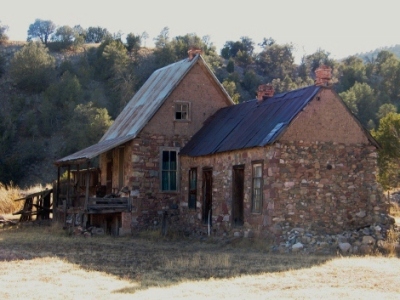
All-in-all, I’ve never seen a ghost town brought back to life so effectively--I mean, even the general store’s original merchandise is on display--yet maintaining that sense of remoteness, both in time and place. It’s utterly charming. You’ve really gotta go sometime.
The first place to go for information on Chloride is their WEBSITE, which offers all sorts of history, much more than I could summarize here. As usual, I also used a good bit of information from Philip Varney. I even scanned his photo of the Pioneer Store and Monte Cristo Saloon for comparative purposes. And I used a little bit of information from Ghosttowns.com.
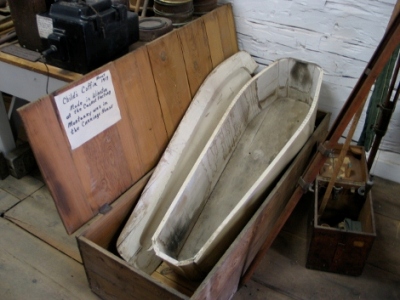
What a great little find this town is. I love to explore and take pictures of places like this. Your photos are fantastic and give you a feel of what this place is like today. It is awesome to see some of the buildings still standing.
ReplyDeleteThanks for the great story! I always enjoy readin' yer writin'!
ReplyDeleteGreat article! I enjoyed your story on Photoblogs on Augusta. Great writing!
ReplyDeleteWe are planning on visiting Chloride later this year. Since you are out and about, are you planning on participating in the New Mexico Centennial "Get The Picture" contest?
ReplyDeleteI've had every intention of participating in the contest and have done a terriblejob of getting shots, so far. Hopefully, I'll do better this summer. I think Chloride just might be one of the locations'
ReplyDeleteThanks for your comment' JM
Thanks for the wonderful journey through Chloride. My great great grandmother was buried there in 1904. I'd love to visit some day.
ReplyDeleteThat's very interesting that your great, great grandmother is buried in Chloride. There is a small cemetery in the town, although we didn't visit it on our trip (which is kinda unusual for us, actually) so I can't speak to its condition. Chloride is certainly worth a visit under any circumstances and even more so for you, I think. It does take some planning to get there though.
ReplyDeleteThanks for your comment! JM
I would so love to visit this town!!! Thanks for what you do.
ReplyDelete